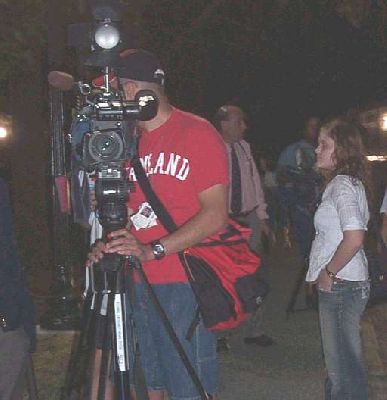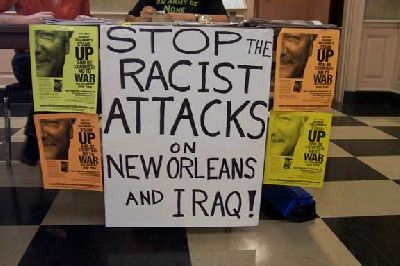Baltimore IMC : http://www.baltimoreimc.org
LOCAL Interview :: Media : Military : Peace : Protest Activity : War in Iraq
How Did Cindy Sheehan Reach the Tipping Point to Become a Mass Media Phenomenon?
This short article surveys the views of local media member’s on the question of “Why Cindy Sheehan hit the Tipping Point and Became a Mass Media Phenomenon?” The interviews were conducted at Cindy Sheehan’s September 20, 2005 appearance at the Johns Hopkins University’s Homewood campus. Concepts from the book “The Tipping Point” are presented to gain more insight into possible answers to this question.
It’s difficult for anyone to rise from obscurity into the National consiousness, but in terms of corporate media attention, Cindy Sheehan has done that. Sheehan is the mother of Casey Sheehan who died in Bush’s Iraq war.
Why is Cindy Sheehan a mass media celebrity when other mothers of soldiers killed in Iraq, who also have been speaking out publicly, didn’t catch on? I posed this question to some of the local media reporters who were covering Cindy Sheehan at Johns Hopkins Shriver Hall the evening of September 20.

Bob Costantini of WYPR conveyed to an Australian journalist, from SBS Television, that Sheehan’s visit is to Hopkins is a “must cover” event. “She decided to make a very public statement. The logic said her efforts would be futile, but she stuck with it and emerged as a voice for the peace movement.” So, in Costantiti’s view, persistence seems to have played a role.
Lowell Melser of WBAL said she was able to take the initiative that others wished they could have taken. “She’s done what others with they could do. She’s actually done it.” Lowell did concede that is something of a mystery; some will try and not catch on. Some others just hit it right. So, Melser’s view might be captured by the saying, “90% of success is just showing up.”

Keith Daniels of Fox 45 responded to my question as if I wasn’t serious. To him the reason for the media explosion around Cindy Sheehan was obvious. “She did it effectively by camping out on the President’s front door.” She had a message, “She wouldn’t leave without getting a meeting with the President.” Fox 45 photojournalist Frank Rios agreed, “She set up shop. She got the attention of the media. That’s why we’re here following her footsteps.” So, Daniels and Rios feel that Sheehan’s “tactics” were the critical factors; protest in Crawford, TX and have a catchy message.
Malcolm Gladwell helps explain these kinds of pop culture phenomena using the science of health epidemics as a model in his book who wrote “The Tipping Point: How Little Things Can Make a Big Difference.” There are three key elements that seem to trigger explosive health epidemics. These are the people who transmit the infection, the potency of the infecting agent, and the environment or setting in which the agent is spread. Gladwell generalizes these in terms of agents of change 1) The Law of the Few, 2) The Stickiness Factor, and 3) the Power of Context.
In most epidemics, or mass social phenomena, a few very active individuals seem to get things going. That’s Cindy and the key people who made Camp Casey in Crawford, TX a success. You might say that Costantini captured this in terms of Cindy Sheehan’s “persistence.”
The infectious agent in this case was the subject of a mother loosing her son in a war based on false pretext. That’s a pretty “sticky” subject in the sense that nearly all parents can personally identify with the anguish of loosing a child. Because the issue is potent, and stands on its own, attempts by Karl Rove and others to undermine Sheehan’s credibility could have little impact. In part, Daniels came close to this element with his comment on Cindy’s “message” of a bereaving mother asking for a meeting with the President.
Perhaps, the issues of justice that are entwined with her message played a role in Cindy becoming a mass media phenomenon. The event at Shriver Hall on September 20 was more like a “Justice” rally than a “Peace” rally. Is Cindy Sheehan awakening American’s feelings about deeper issues of unfair privilege in our society? See Coverage of the Event

What about the third element, the context, or environment, in which the Law of the Few and the Stickiness Factor were acting? Does camping out in Crawford, Texas constitute “context?” Or was it the fact that in August, Congress is out of session, leaving the media open to cover other things? Or was the Nation simply reaching a point of collective disgust with the Iraq war, and thus predisposed to a well-focused messenger? Or are under employed Americans, who continue to see the Bush Administration pass legislation that benefits a small minority, reaching a point where Cindy’s message of taking a stand resonates? It’s hard to say.
I encountered two different views on the potential effect that the mass media response to Hurricane Katrina might have on Cindy Sheehan’s message. One view, held by a local reporter, was that her message was effectively drown out by media attention to Hurricane Katrina. This view cannot be denied in statistical terms of the mass media’s time devoted to Cindy Sheehan. However, a second view is that people will “connect the dots” so to speak between the Cindy Sheehan’s message and the federal government’s inept or callous preparation and response to the Hurricane Katrina debacle. Judging from the large crowed Shriver Hall auditorium, which would have been just as large without the local media presence, this second view might prevail. Perhaps you have another view on this you’d like to share as a comment below.
Why is Cindy Sheehan a mass media celebrity when other mothers of soldiers killed in Iraq, who also have been speaking out publicly, didn’t catch on? I posed this question to some of the local media reporters who were covering Cindy Sheehan at Johns Hopkins Shriver Hall the evening of September 20.
Click on image for a larger version

Local News Media Cover Cindy Sheehan at Johns Hopkins Homewood Campus September 20, 2005
Bob Costantini of WYPR conveyed to an Australian journalist, from SBS Television, that Sheehan’s visit is to Hopkins is a “must cover” event. “She decided to make a very public statement. The logic said her efforts would be futile, but she stuck with it and emerged as a voice for the peace movement.” So, in Costantiti’s view, persistence seems to have played a role.
Lowell Melser of WBAL said she was able to take the initiative that others wished they could have taken. “She’s done what others with they could do. She’s actually done it.” Lowell did concede that is something of a mystery; some will try and not catch on. Some others just hit it right. So, Melser’s view might be captured by the saying, “90% of success is just showing up.”
Click on image for a larger version

Local News Media Cover Cindy Sheehan at Johns Hopkins Homewood Campus September 20, 2005
Keith Daniels of Fox 45 responded to my question as if I wasn’t serious. To him the reason for the media explosion around Cindy Sheehan was obvious. “She did it effectively by camping out on the President’s front door.” She had a message, “She wouldn’t leave without getting a meeting with the President.” Fox 45 photojournalist Frank Rios agreed, “She set up shop. She got the attention of the media. That’s why we’re here following her footsteps.” So, Daniels and Rios feel that Sheehan’s “tactics” were the critical factors; protest in Crawford, TX and have a catchy message.
Malcolm Gladwell helps explain these kinds of pop culture phenomena using the science of health epidemics as a model in his book who wrote “The Tipping Point: How Little Things Can Make a Big Difference.” There are three key elements that seem to trigger explosive health epidemics. These are the people who transmit the infection, the potency of the infecting agent, and the environment or setting in which the agent is spread. Gladwell generalizes these in terms of agents of change 1) The Law of the Few, 2) The Stickiness Factor, and 3) the Power of Context.
In most epidemics, or mass social phenomena, a few very active individuals seem to get things going. That’s Cindy and the key people who made Camp Casey in Crawford, TX a success. You might say that Costantini captured this in terms of Cindy Sheehan’s “persistence.”
The infectious agent in this case was the subject of a mother loosing her son in a war based on false pretext. That’s a pretty “sticky” subject in the sense that nearly all parents can personally identify with the anguish of loosing a child. Because the issue is potent, and stands on its own, attempts by Karl Rove and others to undermine Sheehan’s credibility could have little impact. In part, Daniels came close to this element with his comment on Cindy’s “message” of a bereaving mother asking for a meeting with the President.
Perhaps, the issues of justice that are entwined with her message played a role in Cindy becoming a mass media phenomenon. The event at Shriver Hall on September 20 was more like a “Justice” rally than a “Peace” rally. Is Cindy Sheehan awakening American’s feelings about deeper issues of unfair privilege in our society? See Coverage of the Event
Click on image for a larger version

Some People are "Connecting the Dots" between the Failures of Iraq and the Federal Response to Hurricane Katrina
What about the third element, the context, or environment, in which the Law of the Few and the Stickiness Factor were acting? Does camping out in Crawford, Texas constitute “context?” Or was it the fact that in August, Congress is out of session, leaving the media open to cover other things? Or was the Nation simply reaching a point of collective disgust with the Iraq war, and thus predisposed to a well-focused messenger? Or are under employed Americans, who continue to see the Bush Administration pass legislation that benefits a small minority, reaching a point where Cindy’s message of taking a stand resonates? It’s hard to say.
I encountered two different views on the potential effect that the mass media response to Hurricane Katrina might have on Cindy Sheehan’s message. One view, held by a local reporter, was that her message was effectively drown out by media attention to Hurricane Katrina. This view cannot be denied in statistical terms of the mass media’s time devoted to Cindy Sheehan. However, a second view is that people will “connect the dots” so to speak between the Cindy Sheehan’s message and the federal government’s inept or callous preparation and response to the Hurricane Katrina debacle. Judging from the large crowed Shriver Hall auditorium, which would have been just as large without the local media presence, this second view might prevail. Perhaps you have another view on this you’d like to share as a comment below.
Views
Information
Search
This site made manifest by dadaIMC software

